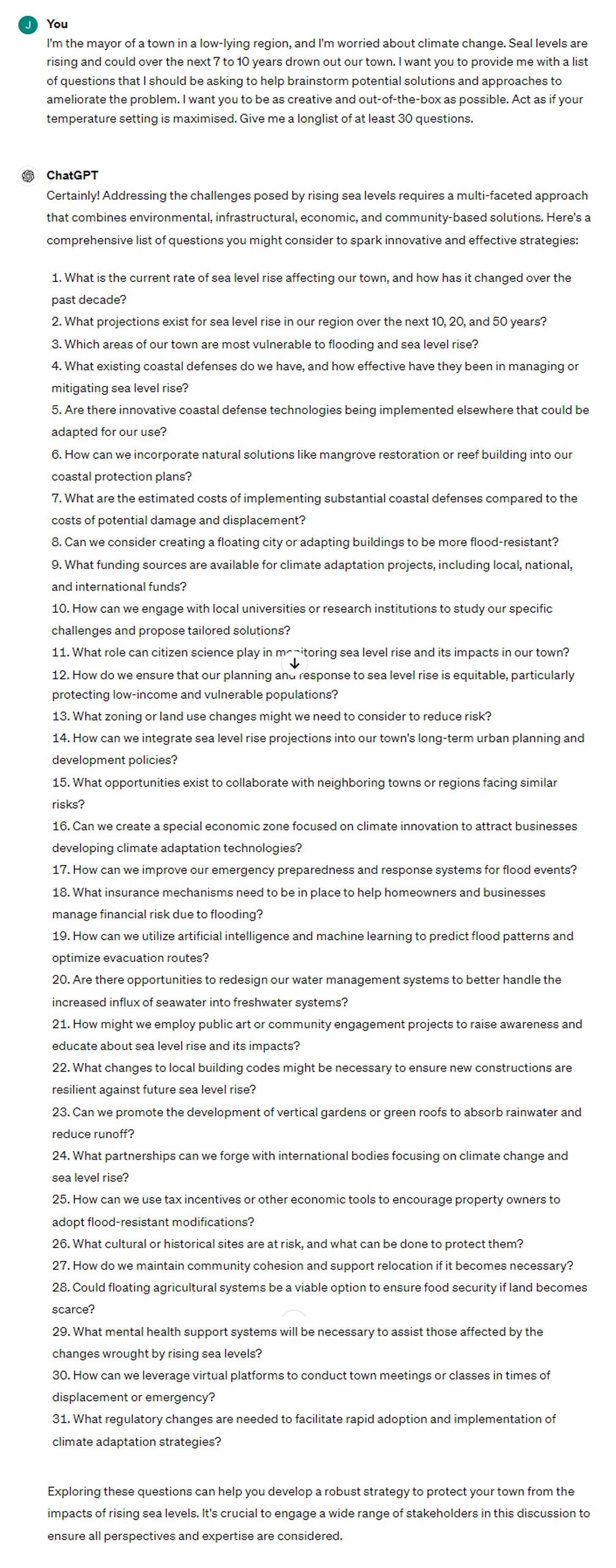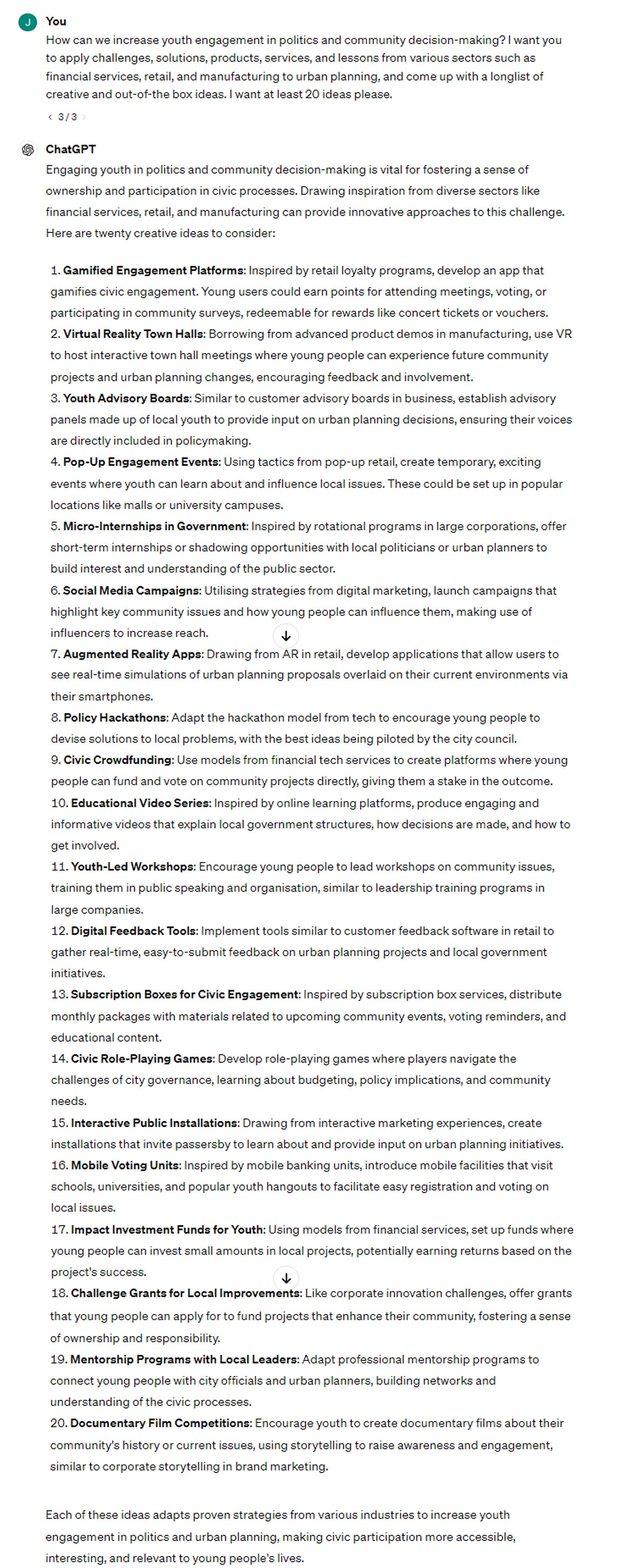AI Tips #6: Innovative Approaches to Brainstorming with AI
AI can be an incredibly potent brainstorming partner for us, but we need to be creative in the way we leverage such tools for problem solving, creativity, and innovation

Brainstorming Matters
The ability to derive unique insights, come up with both practical and whacky ideas, as well as to develop innovative solutions to problems is very much the lifeblood of successful businesses and organisations, and is highly valuable regardless of your role, seniority, or sector.
Some of us might associate brainstorming with groups of people gathered around a table or a whiteboard, working away in a furious exchange of ideas. Yet the reality is that idea generation most frequently occurs in the individual context, within the confines of one’s mind.
When this need arises, I sometimes find myself at an impasse and in such situations, I’ve found AI tools such as ChatGPT to be incredibly beneficial, serving as a sparring partner and enhancing creativity without replacing the unique ingenuity of human thought.
Why AI-Assisted Brainstorming Often Fails to Impress
In my experience training teams and individuals, a common refrain has been the perceived lack of imagination by AI tools. True enough, the ideas generated by untrained users of AI tools often comes across as generic or irrelevant to the specific challenges they face.
Yet contrary to the belief that AI cannot match human creativity, several recent studies have shown that AI can generate more and often more innovative ideas than the majority of humans.
One study, employing the widely-used Torrance Test of Creative Thinking (TTCT) has found OpenAI’s ChatGPT-4 to rank in the top 1 percentile of creative thinking, while another study, again using ChatGPT-4, found the AI model to have generated 7x more top product ideas than the average student from a top university.
This shouldn’t really be surprising considering AI's access to a vast quantities of training data, which essentially equates to having a diverse, multi-disciplinary team at your disposal. Only a fraction of a fraction of people are able to consistently generate truly groundbreaking ideas. For the rest of us, AI can massively elevate our creative output when used correctly.
So let’s explore what effective brainstorming with AI looks like.
Cranking Up the AI Idea Factory
When it comes to AI-assisted brainstorming, “using AI correctly” comes down a little to prompt techniques and a lot to how creative you are in using the AI. Let’s explore various approaches, starting with prompting tips.
#1 Prompting Tips
I’ve found two simple prompting tricks to be helpful for brainstorming.
Firstly, indicate in your prompt that you would like the AI to “be as creative, innovative and out-of-the box as possible, and that no idea is too whacky” (or something along those lines). Large Language Models (LLMs) such as ChatGPT work based on probability, and the goal here is to stretch the distribution of its responses. If you’re a more advanced user leveraging OpenAI’s Playground or API, you can achieve the same result by maximising the temperature setting to 1.0.
Secondly, indicate the number of responses you would like. When using ChatGPT for instance, unless otherwise specified, I find that the model defaults to around 10-15 ideas. To get around this issue, I typically ask the AI to return at least 25-30 ideas, and if I really want to spice it up, I ask for at least 50 ideas. Brainstorming is partially a numbers game and with a higher volume of ideas, you’re more likely to land on something that is truly unique and interesting.
#2 Questions Before Answers
Awhile ago, I read an HBR article (“Better Brainstorming”) whose main premise was that when looking to solve problems or challenges, its a lot more effective to start by brainstorming questions about the problem before jumping into potential solutions.
I’d already found this approach to be highly potent even before the emergence of ChatGPT, and have since incorporated it into how I leverage brainstorming with AI.
In the example below, in my (hypothetical!) role as a mayor of a town under threat of rising sea levels, I’ve asked ChatGPT to help with deriving potential questions that I should be asking about this problem. Each of these questions opens interesting new avenues of enquiry that I would never have otherwise explored.
#3 Structures and Frameworks
As a structured problem solver, I’ve always found frameworks to be very useful in helping me to dissect issues and formulate solutions.
In your prompt, you’ll ask the AI to adopt a particular framework(s) to the problem at hand. The framework will naturally vary according to the nature of the challenge. As a consultant, I tend to use strategy and innovation frameworks such as Porter’s Five Forces, and Strengths, Weaknesses, Opportunities and Threats (SWOT), 5 Whys, and Ten Types of Innovation. There are also generic brainstorming approaches such as Six Thinking Hats and Starbursting which can be used for a variety of problems.
This is not meant to be a post about frameworks, so my advice for you is to simply choose whichever framework you are comfortable with and is relevant to your area of specialisation or enquiry.
In the example below, in my again made up role as CEO of a cancer centre, I’ve asked ChatGPT to help with coming up with potential solutions to patients having to suffer the stress and trouble of having to frequently return to the hospital. I’ve included only half of the answer as it was an extremely long response!
#4 Cross-Pollination
One innovation technique that I sometimes use with clients, known as Cross-Pollination, is to consider the potential challenges, solutions, products, services, and lessons from another sector, discipline, function, or area, and apply it to their particular challenge.
It's an effective approach because it leverages the diverse ways in which different groups of people tackle problems, innovating by adapting solutions that have proven successful elsewhere.
Real world examples include the application of Toyota’s Production System, originally developed to streamline manufacturing processes, being adapted in hospitals around the world to improve efficiency and patient care, and the ‘borrowing’ of gamification techniques used in video games in educational settings to enhance learning experiences and improve student engagement and retention rates.
The example below applies lessons from various sectors to the problem of trying to increase youth engagement in politics and community decision-making.
#5 Introducing Constraints
One of the most counterintuitive yet effective techniques for unlocking creativity is the introduction of constraints. It's an old adage that creativity thrives under constraint. When faced with limitations, we are often pushed to think more deeply and creatively, exploring paths we might otherwise ignore.
In his blog
, Wharton professor highlights this intriguing approach in an article about generating ideas with AI. When it comes to new product solutions for instance, he provides the example of considering extreme users (e.g., a toothbrush designed for an astronaut) as a method to force novel thinking. This technique steers us (and the AI) away from the typical assumptions we make about the world around us, and naturally elicits more out-of-the-box ideas.If you’re interested to apply this technique, here are some leftfield (aka whacky) scenarios for you to try out:
Eco-Survivor Scenario: How would someone living entirely off-grid in a remote forest use a tool you've developed to enhance their survival or daily life?
Superhero Gadget: How might a superhero use your conflict resolution strategy as a tool in their arsenal? What special modifications would be required?
Underwater Living: How would your educational program need to change if it were to be taught in an underwater community? What elements would be essential to engage and educate in this environment?
Child’s Play: How would a child apply a decision-making model you teach in a fun, educational game? How can this model help them learn important life skills?
Runaway’s Toolkit: Someone on the run from a secret conspiracy might need to disguise their identity or location. How could they use your data privacy or security advice to remain undetected?
Get Storming!
To harness the true power of AI in brainstorming, we must approach it with intentionality and creativity. Take the time and effort to shape your very own creative approaches to brainstorming with your AI partner, and you will not be disappointed!
Please share your approaches, techniques, and examples of brainstorming with AI!
Justin Tan is passionate about supporting organisations and teams to navigate disruptive change and towards sustainable and robust growth. He founded Evolutio Consulting in 2021 to help senior leaders to upskill and accelerate adoption of AI within their organisation through AI literacy and proficiency training, and also works with his clients to design and build bespoke AI solutions that drive growth and productivity for their businesses. If you're pondering how to harness these technologies in your business, or simply fancy a chat about the latest developments in AI, why not reach out?






